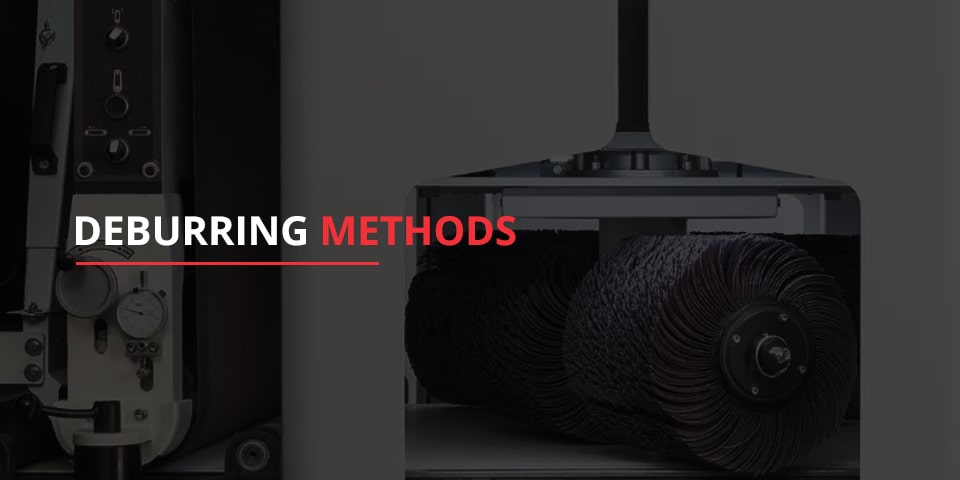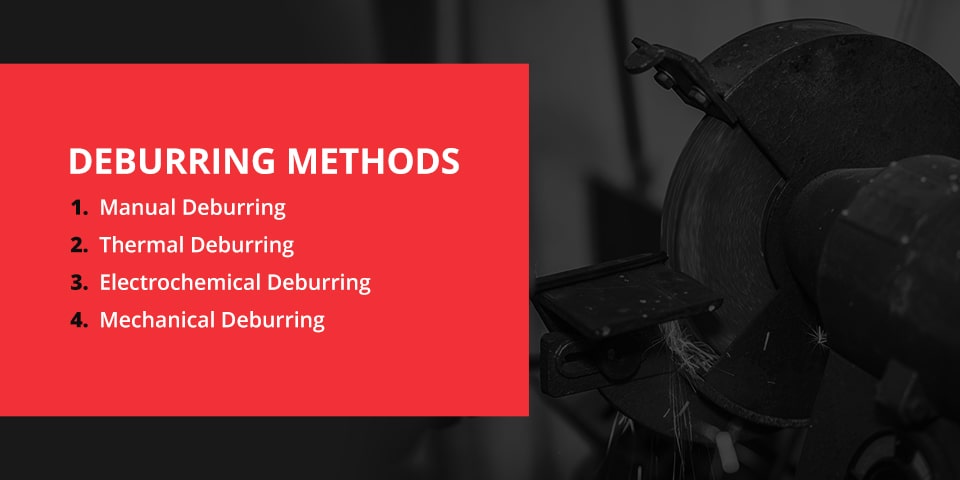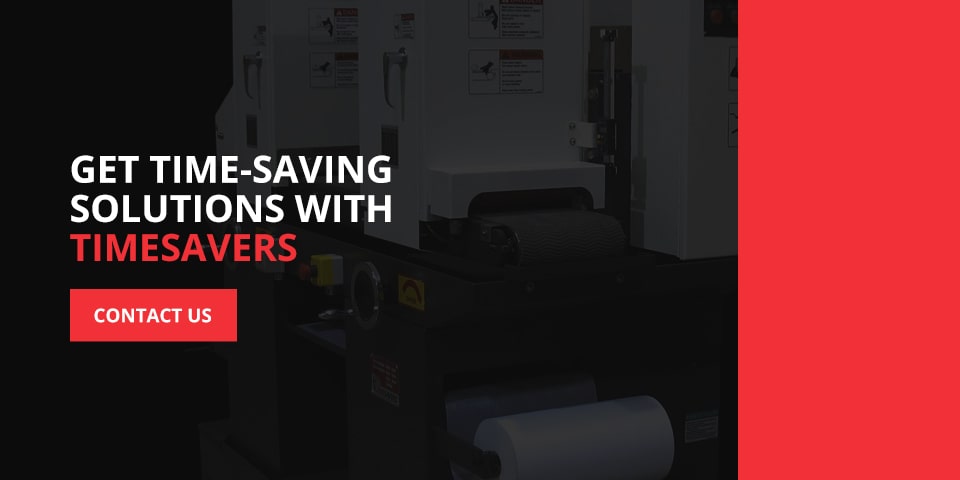Deburring Methods

For many industries, it’s critical to have dependable parts and machines that give you consistent, accurate results. Many different projects, particularly those involving metal, require extreme attention to detail and precision to keep your operations productive and produce predictable outcomes.
It’s important to have tools and machines on hand to keep your metal smooth, avoid any hazardous situations and prevent your existing workpieces from malfunctioning with a procedure known as deburring. Let’s explore what deburring means and the different types of deburring processes you can use to keep your workpieces and parts in good shape.
What Is Deburring?
Deburring is a process that removes imperfections and sharp edges, called burrs, from a material — usually machined metal products — and leaves it with smooth edges. During many manufacturing processes, machines use different operations such as drilling, mining, engraving and grinding to form and shape metal into various parts, which can create rough edges that affect fasteners and materials.
There are two primary types of burrs, loose and fixed. Loose burrs are relatively easy to remove, while fixed burrs require more tools or extensive deburring methods. Deburring is an important procedure because it helps remove unwanted protrusions and small ridges from tools and components to maintain their quality.
Deburring is a helpful technique to use after machining or welding operations to produce a reliable, smooth metal piece. Without consistent deburring, burrs can cause longevity, safety and functionality issues such as:
- Material cracks and failures
- Excessive friction and heat
- Increased wear and corrosion at interfaces
- Damage to the assembly

Deburring Methods
Deburring can be performed using many different methods. Different burr types will arise depending on how the machining processes and tools enter, exit or cut the material. Depending on the metal and application, you may need to use several deburring methods to successfully remove your burrs, but it’s typically an easy process.
Keep in mind that each deburring method will also produce a different result on the dimensions and surface quality of the material. While there are many different ways to remove burrs, here are the top four most popular methods for deburring.
1. Manual Deburring
Manual deburring is one of the most economical and common methods that require simple handheld tools to buff, sand or scrape burrs out of the metal parts and pieces. Manual deburring is also known as a localized process, which means it doesn’t affect the entire part.
Though this process is easy to conduct, it’s also slow and time-consuming, so it can impact operational productivity. Here are some types of manual deburring:
Brushing
The brushing method consists of using brushes with different metal or wire filaments on a rotating disc to manually scrape off burrs. While this method is relatively fast and low-cost, it may have consistency and intensity limits depending on the texture, material type, density, filament diameter and angular velocity.
Sanding or Bonded Abrasive Finishing
The sanding method uses abrasive materials such as zirconia or aluminum oxide to create discs, pads, belts and wheels. Using a rotating action, the abrasives remove the raised materials on the surface of the tool or workpiece. These abrasive materials range from coarse to fine, which can work well depending on the texture and characteristics of the material that needs to be deburred and the desired surface finish.
Sheet Metal Edging
The sheet metal edging method is a manual deburring process that uses stationary machines with small grinding wheels to smooth the sheet metal edges with varying thicknesses. These machines have multiple sets of rollers that use force and pressure to deburr the raised edges. While this method is efficient, it can warp malleable materials under intense pressure, so it’s important to control these processes.
2. Thermal Deburring
Thermal deburring is a process that targets burrs in hard-to-reach areas on multiple surfaces simultaneously. This fast-paced energy method uses heat and combustive, corrosive gases to create thermal energy and shockwaves that vaporize the burrs and scald them out of the metal.
As the heat builds up, it causes the burrs to dissolve, though the workpiece itself remains unaffected by the heat and gasses because of its short exposure time. A thermal deburring process works best on low conductivity materials that can easily oxidize or burrs on cracks or crevices.
Cryogenic Deburring
Cryogenic deburring uses liquid nitrogen and a flashing process within a chamber containing the materials that need deburring. The flashing process cools the temperature of the chamber and embrittles the burrs. With the help of abrasives tumbled in the chamber, it removes the burrs.
3. Electrochemical Deburring
Electrochemical deburring is a method that uses electrolysis to get rid of burrs using anodic metal dissolution. The workpiece or part with burrs is attached to a circuit and submerged in an electrolyte. An insulated, cathodic tool is shaped to become a negative of the workpiece and focus the electrolysis and anodic reaction only in the areas where burrs are located to avoid dissolving or wearing the rest of the piece.
The electrochemical deburring process is highly accurate and transfers a charge between the tool and the workpieces to remove burrs on extremely challenging metals. However, this process does use harmful chemical compounds, so it’s not as environmentally friendly as other deburring options.
4. Mechanical Deburring
The mechanical deburring process, also referred to as automated deburring, consists of machines that perform a general grinding deburring on the workpiece. This option is much more efficient, so it can be used in a wide variety of machining operations. There are many different types of mechanical deburring, but here are some examples of machines that can get the job done:
- 11 Series machines: Using an 11 Series machine enables you to produce a perfectly finished part with the ability to remove vertical burrs from many different types of materials. This machine operates wet, with a built-in dryer, paper belt filter, recirculation pump and coolant filter. This type of machine is easy to use and works with many different mixed metals, like copper, aluminum, titanium and others.
- 32 Series RB machines: You can use this machine on different materials to achieve deburring, laser oxide removal, finishing and edge rounding. The 32 Series RB machines have several brushes with abrasive materials to remove large burrs in one pass. This machine also gives the operator full control of the entire process thanks to transparent windows and an HMI control panel.
Which Method Is Best for Your Business?
With so many methods to choose from, it can be difficult to determine which is most efficient for your business. The best method to use will differ depending on your manufacturing and industry needs. Still, mechanical deburring is one of the top methods for deburring because of its many benefits, including:
- Is scalable and flexible to each type of product
- Requires no pretreatment
- Provides consistent quality thanks to automation
- Saves time, labor and costs, leading to more productivity
- Handles process components of any shape or size
- Works for many different materials, even those with complex contours
- Removes fixed or loose machining burrs regardless of size
- Improves durability and functionality of metal components
With mechanical deburring, you can be confident in an efficient, reliable and fast technique to remove burrs entirely from your workpiece structures.
Get Time-Saving Solutions With Timesavers
At Timesavers, we know how critical it is to be able to rely on your machines and keep your business running smoothly. With our advanced technology and commitment to customer service, our machines will help improve your operations with efficient deburring, edge conditioning and many other metal and wood solutions.
We carry many different deburring products for all your business and manufacturing needs. Whether you require finishing for small parts or heavy-duty edge rounding or want a machine that fits your other requirements, we can find the right option for you in our large machine inventory. Contact us today with any questions about our products or request a quote to get started.

